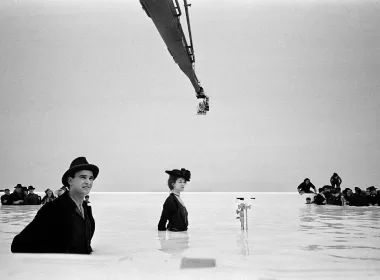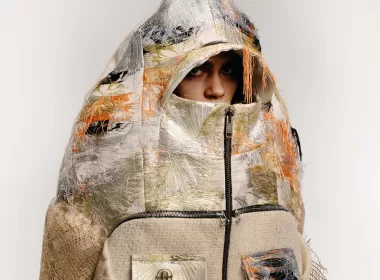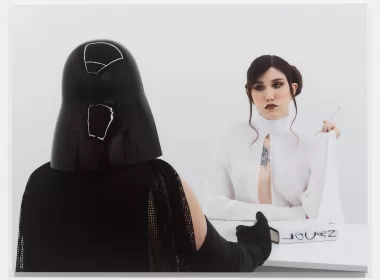In his book Archive Fever, French philosopher Jacques Derrida argues that memory takes place at the point of an original and structural breakdown. Here, the French philosopher borrows from Freudian theories, suggesting that the archive, like memory, is a space where presence and absence coexist, where recollection is tainted by what has been forgotten or repressed. The concept of memory is the base of the latest collection by Juan Pablo Espínola, a Chilean fashion designer with an architectural background, who explores in his latest collection the theme of fragmented memory. In “Glimmers Amidst The Ominous Abyss”, Espínola embraces his experimental spirit, creating garments that could be seen as installations due to their imposing geometric structures.
Textured surfaces are enriched with embroidery and brushstrokes of color. A distinctive feature of his practice is the use of voluminous layers created from stiff fabrics. This contrasts with the softness of other materials, creating a play of volumes that destabilizes the traditional proportions of the human body. In this interview Espínola generously shares aspects about his journey. Such as how his experience in Antwerp has intertwined with his Chilean roots, influencing his creative practice. In Espínola’s latest work, he explores the concept of memory from two perspectives: memory as an effort to preserve the past, and on the other hand, the acceptance of a new identity that comes from forgetting.
While Derrida sees memory as inherently tied to what is forgotten or repressed, with the process of archiving destined to fail in fully preserving the past. In contrast, Espínola embraces this fragmentation of memory as an opportunity to build new identities. In his designs, the act of forgetting becomes a transformative process that generates new creative possibilities, allowing for the reinvention of the self. In other words, Derrida views fragmentation as a threat, Espínola interprets it as a generative force for innovation and personal renewal.
What are the most important aspects of your identity? And how do these aspects influence your work?
Juan Pablo Espínola – It is very hard to answer that question…I think the most important aspect of my identity is that it swings from one side to another all the time, shifting from what I’ve done before, in the search of artistry of creative excitement or in a way to find new creative expressions. I think this ever-changing attitude just fuels my passion for creativity and keeps me inspired to always explore and try to innovate.
How has moving to Antwerp influenced your creative process? Were there specific aspects of the culture or atmosphere of Antwerp that had a significant impact on you?
Juan Pablo Espínola – I think on the contrary, moving to Antwerp was not just about accessing to high fashion education and a platform through the prestigious Royal Academy of Fine Arts Antwerp’s fashion program; for me, its greatest influence has been about finding ways to protect and understand my creativity and thought processes. It has influenced me in making these process as conscious as possible, tracing back to what inspired me from a young age and developing a method to understand and evolve these inspirations into weekly physical fashion work. Living in Antwerp has profoundly shaped the complexities of my work. It has balanced and help me understand the spontaneous aspects of my creativity with a more calculated, meticulous approach. This journey in Antwerp has been about both safeguarding and consolidating my vision, reinforcing my confidence as designer, but mostly, as a researcher of ideas.
How has your cultural background mixed with what you learned in the academy? Are there beliefs you have reconsidered and any that you have solidified through this experience?
Juan Pablo Espínola – In addition to my previous answer, being Chilean means that we inherently understand isolation and diversity, which fosters a strong ability to adapt. This allows us to balance global influences with a deep connection to our heritage. I believe this unique blend is evident in my work, even though I express this sense of heritage in a more abstract and personal manner, rather than as a direct form of identification.
Furthermore, I am also an architect, so I approach design in a distinctive way. I see it as akin to designing a building, where everything is layered—structure, materiality, and details—all coming together as a cohesive whole.
In your third collection “Glimmers Amidst the Ominous Abyss,” you are inspired by the loss of memory. Can you tell us what inspired this? Do you think you have found some kind of antidote to counter this loss?
Juan Pablo Espínola – I did not find an antidote, but I did uncover more questions. It all started when I listened to ‘Everywhere at the end of time’ by The Caretaker (Leyland Kirby), which portraits music as a progression of Alzheimer’s disease. This concept captivated me, leading me to explore mental illness and its relationship with memory.
I discovered that there are two distinct paths in this mental process: one focuses on preserving memories and trying to remember who you are, even if it means making mistakes along the way. The other path involves entering a new realm of knowledge-forgetting, where you question your identity, rename things, and invite others to engage with this new version of yourself. It’s a process of embracing a new self, leaving the past behind, and discovering new possibilities in a positively transformative way. From these paths is where the collection began.
In your creations, you also use unorthodox materials. On a practical level, what challenges do you encounter in using these materials? How do you manage to combine aesthetics with your communicative needs?
Juan Pablo Espínola – It’s about translating these emotions into visual and material expressions. For instance, I might repurpose the lining of a jacket as the fabric of a coat, blending different elements within a single piece, so you have two ways of wearing in one, but you can also have no ways of wearing it.In this collection, the ‘wrong’ side can become the ‘right’ side, to try to portrait the feeling that ‘even if you’re still trying to do it right, it will still be wrong…but wrong according to what reality?’. The deconstruction is important and even the pattern papers used in the garment’s creation are reimagined. I’ve painted these papers in gold, transforming them into a new element of the design.
I combine unconventional materials like kitchen towels,loose yarns, kraft paper, and the backs of jacquards with leather, cotton, denim, and other leftover textiles. This approach aims to blur the lines between the ephemeral and the tangible, creating a dynamic interplay between memory, identity, and materiality.
In an industry often dominated by trends, how do you manage to maintain your authenticity and unique identity in your work? Is this something you are keen to pursue?
Juan Pablo Espínola – For me, trends are there to be understood, but not to dictate my work. In a politically correct answer, if a particular color is trending, I might choose not to follow it. What is more compelling to me is how a trend, such as ‘covering your face’ for instance, can be explored in a deeply unique personal way. Now, the honest answer is that I ultimately focus on what it feels right to me, I never check what is trending and I just hope to connect with people who will find my work somehow relatable or intriguing.
How do you envision your typical customer? Is there any famous person, not necessarily connected to fashion, who you would like to see wearing your creations for their aesthetics or lifestyle?
Juan Pablo Espínola – I really don’t know how to answer that. It makes me happy when, more than famous people, everyday life persons can find a way that my clothes match their taste, their support my work even if they don’t buy or wear it, or if they can feel confident to wear it. I especially love when my mom wears my stuff.























